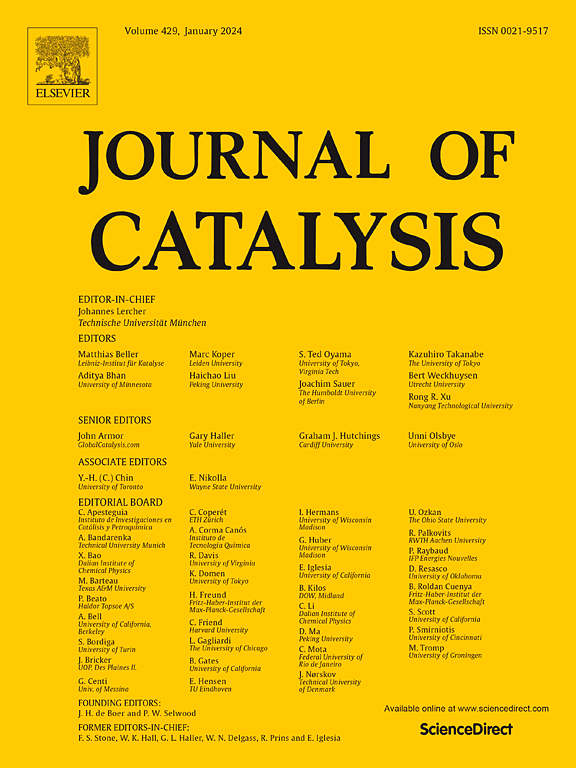植物光依赖性原叶绿内酯氧化还原酶催化质子耦合电子转移反应的光/热双立方机制
IF 6.5
1区 化学
Q2 CHEMISTRY, PHYSICAL
引用次数: 0
摘要
在叶绿素生物合成过程中,光依赖性原叶绿素内酯氧化还原酶(LPOR)是为数不多的天然光依赖性酶之一,依靠辅助因子NADPH催化原叶绿素内酯转化为叶绿素内酯。然而,获得LPOR光催化机制的具体细节是具有挑战性的,因为中间物质通常是复杂的,而感兴趣的化学步骤往往是动力学模糊的。本文采用全原子分子动力学模拟和电子结构计算,结合振动非绝热质子耦合电子转移(PCET)理论,研究了与lpoor内C17C18键光还原综合机理相关的光化学。计算的电子激发谱和势能面表明,在LPOR活性中心中精细调制的光隙有利于空穴-电子分离和系统间交叉进入三重态,从而促进了LPOR的有效光氧化还原催化。通过确定电荷转移反应前后与活性位点构型相关的反应能量路径,揭示了电荷转移反应的静电耦合性质。整个反应最终被描述为氢原子转移和随后的电子和质子逐步转移过程。本研究为研究ppet在酶促环境下的光催化作用提供了新的视角。本文章由计算机程序翻译,如有差异,请以英文原文为准。


Photo/thermo bi-cube mechanism of proton-coupled electron transfer reaction catalyzed by plant light-dependent protochlorophyllide oxidoreductase
Light-dependent protochlorophyllide oxidoreductase (LPOR), one of the few natural light-dependent enzymes relies on the cofactor NADPH to catalyze the conversion of protochlorophyllide to chlorophyllide during chlorophyll biosynthesis. However, acquiring the specific details of LPOR photocatalysis mechanism is challenging, as the intermediate species are generally complex and the chemical steps of interest are often kinetically obscure. Herein, the photochemistry associated with the comprehensive mechanism of C17![]() C18 bond photoreduction inside LPOR was investigated using all-atom molecular dynamics simulations and electronic structure calculations in conjunction with vibronically nonadiabatic proton-coupled electron transfer (PCET) theory. The calculated electronic excitation spectrum and potential energy surfaces demonstrated that the finely modulated optical gap in the LPOR active center facilitates hole-electron separation and intersystem crossing to access the triplet states, which promotes effective photoredox catalysis by LPOR. The electrostatic coupling nature of the charge transfer reactions was revealed by determining the reaction energy paths related to the active site configuration prior to and after the transfer. The entire reaction was ultimately described as hydrogen atom transfer and subsequent stepwise electron and proton transfer process. This work provides a new perspective on the photocatalysis PCET in enzymatic environment with biochemistry relevance.
C18 bond photoreduction inside LPOR was investigated using all-atom molecular dynamics simulations and electronic structure calculations in conjunction with vibronically nonadiabatic proton-coupled electron transfer (PCET) theory. The calculated electronic excitation spectrum and potential energy surfaces demonstrated that the finely modulated optical gap in the LPOR active center facilitates hole-electron separation and intersystem crossing to access the triplet states, which promotes effective photoredox catalysis by LPOR. The electrostatic coupling nature of the charge transfer reactions was revealed by determining the reaction energy paths related to the active site configuration prior to and after the transfer. The entire reaction was ultimately described as hydrogen atom transfer and subsequent stepwise electron and proton transfer process. This work provides a new perspective on the photocatalysis PCET in enzymatic environment with biochemistry relevance.
求助全文
通过发布文献求助,成功后即可免费获取论文全文。
去求助
来源期刊

Journal of Catalysis
工程技术-工程:化工
CiteScore
12.30
自引率
5.50%
发文量
447
审稿时长
31 days
期刊介绍:
The Journal of Catalysis publishes scholarly articles on both heterogeneous and homogeneous catalysis, covering a wide range of chemical transformations. These include various types of catalysis, such as those mediated by photons, plasmons, and electrons. The focus of the studies is to understand the relationship between catalytic function and the underlying chemical properties of surfaces and metal complexes.
The articles in the journal offer innovative concepts and explore the synthesis and kinetics of inorganic solids and homogeneous complexes. Furthermore, they discuss spectroscopic techniques for characterizing catalysts, investigate the interaction of probes and reacting species with catalysts, and employ theoretical methods.
The research presented in the journal should have direct relevance to the field of catalytic processes, addressing either fundamental aspects or applications of catalysis.
 求助内容:
求助内容: 应助结果提醒方式:
应助结果提醒方式:


